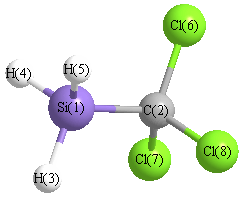Vibrational Frequencies calculated at LSDA/STO-3G
| Mode Number |
Symmetry |
Frequency
(cm-1) |
Scaled Frequency
(cm-1) |
IR Intensities
(km mol-1) |
Raman Act
(Å4/u) |
Dep P |
Dep U |
|---|
| 1 |
A1 |
2630 |
2355 |
0.19 |
|
|
|
| 2 |
A1 |
1002 |
898 |
36.29 |
|
|
|
| 3 |
A1 |
945 |
846 |
157.72 |
|
|
|
| 4 |
A1 |
454 |
406 |
5.02 |
|
|
|
| 5 |
A1 |
278 |
249 |
12.07 |
|
|
|
| 6 |
A2 |
148 |
133 |
0.00 |
|
|
|
| 7 |
E |
2696 |
2415 |
1.02 |
|
|
|
| 7 |
E |
2696 |
2415 |
1.02 |
|
|
|
| 8 |
E |
1039 |
931 |
49.34 |
|
|
|
| 8 |
E |
1039 |
931 |
49.34 |
|
|
|
| 9 |
E |
863 |
773 |
70.31 |
|
|
|
| 9 |
E |
863 |
773 |
70.31 |
|
|
|
| 10 |
E |
664 |
594 |
59.74 |
|
|
|
| 10 |
E |
664 |
594 |
59.74 |
|
|
|
| 11 |
E |
256 |
230 |
0.63 |
|
|
|
| 11 |
E |
256 |
230 |
0.63 |
|
|
|
| 12 |
E |
155 |
138 |
0.18 |
|
|
|
| 12 |
E |
155 |
138 |
0.18 |
|
|
|
Unscaled Zero Point Vibrational Energy (zpe) 8400.8 cm
-1
Scaled (by 0.8955) Zero Point Vibrational Energy (zpe) 7522.9 cm
-1
See section
III.C.1 List or set vibrational scaling factors
to change the scale factors used here.
See section
III.C.2
Calculate a vibrational scaling factor for a given set of molecules
to determine the least squares best scaling factor.
Charges, Dipole, Quadrupole and Polarizability
Charges from optimized geometry at LSDA/STO-3G
Charges (e)
| Number |
Element |
Mulliken |
CHELPG |
AIM |
ESP |
| 1 |
Si |
0.494 |
|
|
|
| 2 |
C |
-0.062 |
|
|
|
| 3 |
H |
-0.054 |
|
|
|
| 4 |
H |
-0.054 |
|
|
|
| 5 |
H |
-0.054 |
|
|
|
| 6 |
Cl |
-0.090 |
|
|
|
| 7 |
Cl |
-0.090 |
|
|
|
| 8 |
Cl |
-0.090 |
|
|
|
Electric dipole moments
Electric dipole components in Debye
(What's a Debye? See section
VII.A.3)
| |
x |
y |
z |
Total |
| |
0.000 |
0.000 |
2.970 |
2.970 |
| CHELPG |
|
|
|
|
| AIM |
|
|
|
|
| ESP |
|
|
|
|
Electric Quadrupole moment
Quadrupole components in D Å
| Primitive |
|---|
| | x | y | z |
|---|
| x |
-55.532 |
0.000 |
0.000 |
| y |
0.000 |
-55.532 |
0.000 |
| z |
0.000 |
0.000 |
-50.290 |
|
| Traceless |
|---|
| | x | y | z |
|---|
| x |
-2.621 |
0.000 |
0.000 |
| y |
0.000 |
-2.621 |
0.000 |
| z |
0.000 |
0.000 |
5.242 |
|
| Polar |
|---|
| 3z2-r2 | 10.484 |
|---|
| x2-y2 | 0.000 |
|---|
| xy | 0.000 |
|---|
| xz | 0.000 |
|---|
| yz | 0.000 |
|---|
|
Polarizabilities
Components of the polarizability tensor.
Units are
Å
3 (Angstrom cubed)
Change units.
| |
x |
y |
z |
| x |
5.214 |
0.000 |
0.000 |
| y |
0.000 |
5.214 |
0.000 |
| z |
0.000 |
0.000 |
3.604 |
<r2> (average value of r
2) Å
2
| <r2> |
279.330 |
| (<r2>)1/2 |
16.713 |
